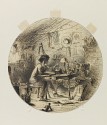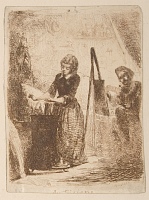KEYWORD
brazier, easel, food, garret, interior, man seated, model, self-portrait, studio, pipe.
TITLE
Whistler's original title was adopted by later cataloguers, as follows:
'
Au Sixième
' (1857, Whistler).
3
'
Au Sixième
' (1909,
Howard Mansfield (1849-1938)).
4
'
Au Sixième' means that the setting is on the sixth floor of a tenement building in Paris. The title may be a pun, for it also implies that the room is in the
6ième (6th) Arrondissement in Paris - the area encompassing the Sorbonne and the École des Beaux Arts.
DESCRIPTION
It shows an artist's studio. At front left, a young women is stirring a pot on a small cylindrical stove with her left hand, her right hand holding a cigarette. She has loose, shoulder-length curly hair, a long, close-fitting bodice with white collar, wide sleeves rolled up to the elbow, and a full skirt. Behind her, and to right, a dark, bearded man wearing a bonnet is smoking a pipe and painting a picture on an easel. On the wall at the back are a hat, a palette, a crowded shelf and a pipe rack.
SITTER
The model is
Eloise ('Fumette') (fl. 1840-1858), who posed for
Fumette
[12], an impression of which is reproduced below.
Lochnan suggested the man might be
Ernest Delannoy (d. 1860/1870); however, the features do not closely resemble Ernest's as they appear in several drawings by Whistler that were made during the following year, such as
Blanchissage à Cologne
[m0277], and by then Ernest did not have a beard.
5
SITE
The interior of a studio in Paris, on the sixth floor. The studio shown in the etching might have been rented by Whistler or a friend. The Pennells mention that 'For a while, when remittances ran out, [Whistler] climbed his six flights and shared a garret with Delannoy.' 6
The title also suggests that the studio was in the 6ième (6th) Arrondissement, on the Left Bank of the Seine, also known as the Latin Quarter, the area encompassing the Sorbonne and the École des Beaux Arts, and thus the centre of art student life. During his student years, Whistler is recorded at 1 rue Bourbon-le-Chateau, in rue Saint-Sulpice and at 35 rue Jacob, all in the 6ième Arrondissement; 3 rue Campagne-Première (14ième Arrondissement); 11 rue Poupée (5ième Arrondissement, later absorbed into the Rue Saint-Michel); 18 rue de Chabrol (10ième Arrondissement; 7 rue Galères; and 8 rue de Paradis-Marais.
A romantic view of the studio of a young artist is seen in an early pen drawing (An artist in his studio
[m0211]) reproduced below.
 An artist in his studio
An artist in his studio
[m0211], pen and ink,
Freer Gallery of Art.
DISCUSSION
Thomas Armstrong (1832-1911), commented on the subjects etched by Whistler and his friends:
'Whistler's represented an interior ... I think it was, in composition, something like Tassaert's well-known picture in the Luxembourg, a garret with female figures. Poynter's was in the style of the illustrations to Balzac's Contes Drolatiques by Doré, his best work with which we were all much impressed at that time. It represented a French castle with many turrets dark against the sky, and from the upper part of it, a beam or gallows projected with a skeleton dangling from it. I cannot recollect what subjects Lamont and I chose, but I believe the plates were never bitten, certainly mine was not.' 7
An impression from Du Maurier's plate, entitled George Louis Palmella, Comte Busson du Maurier, with Madame la Comtesse and Monsieur le Vicomte, was owned by Armstrong until his death in 1911, but has not been located. 8
8: Lochnan, op. cit., pp. 21-23. Leonée Ormond, George du Maurier, Routledge & Kegan Paul, London, 1969.
A unique impression of Poynter's print is in the British Museum, catalogued as 'A skeleton hanging on a rope from the turret of a castle overlooking a lake; cat on the roof; island in middle ground at right, hills in background.' 9 Poynter's print is a small (161 x 107mm) etching and drypoint. Whistler's etching was even smaller, at 108 x 77 mm.
9: British Museum 1930,0130.31; website at
http://www.britishmuseum.org (accessed 2012); wrongly dated 1867 in the catalogue.
Armstrong drew comparisons between Whistler's work and that of Octave Tassaert (1800-1874) and
Paul Gustave Louis Christophe Doré (1832-1883). Tassaert's
An Unfortunate Family or
The Suicide, mentioned by Armstrong as in the Luxembourg, is now in the Musée Fabre, Montpellier. Commissioned by the state in 1849, it was well received at the 1850/1851 Salon. Lochnan comments:
'Although the subject of Whistler's work is as light-hearted as Tassaert's is grim, the composition is not dissimilar, and employs much the same type of sloping garret roof and chiaroscuro lighting effects as the painting. Tassaert ... was a neighbour of the English Group at 5 rue Notre-Dame-des-Champs in 1857.' 10
10: Lochnan, op. cit., pp. 21-23.
Honoré de Balzac's Les Cent Contes drolatiques, with over 450 illustrations by Doré, was published in Paris by C. Gosselin and E. Werdet, 1832-1837. In later years Whistler was not an admirer of Doré's work: in 1876, when a friend praised Doré, Whistler was, as Alan Cole noted in his diary, 'very amusing in opposition'. 11 However Whistler's later and darker subjects, such as The Beggars and The Two Doorways do suggest a certain affinity with Doré's work.
11: A. S. Cole, diary, 10 March 1876, GUW #13132.


